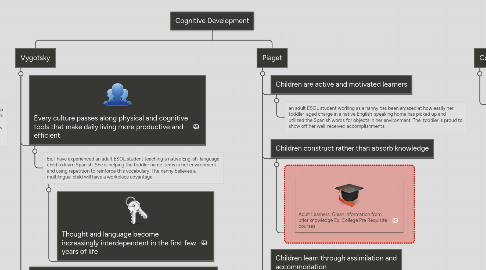
1. Piaget
1.1. Children are active and motivated learners
1.1.1. an adult ESOL student working as a nanny has been amazed at how easily her toddler-aged charge in a native English-speaking home has picked up and utilized the Spanish words for objects in her environment. The toddler is proud to show off her well-received accomplishments.
1.2. Children construct rather than absorb knowledge
1.2.1. Adult Learners: Glean information from prior knowledge Ex: College Pre Requisite courses
1.3. Children learn through assimilation and accommodation
1.4. Interactions with one’s physical and social environment are essential for cognitive development
1.5. The process of equilibration promotes progression toward increasingly complex thought
1.5.1. Adult Learners: Constantly encountering situations that create disequilibrium Ex: Technology/course management systems
1.6. Due to maturation of brain, children think in qualitatively different ways at different stages
1.6.1. The ESOL nanny is working with a toddler who is just learning to speak. It appears that the child is a tabula rasa and her teacher is extremely motivated! A win/win situation.
2. Vygotsky
2.1. Every culture passes along physical and cognitive tools that make daily living more productive and efficient
2.1.1. Ex. I have experienced an adult ESOL student teaching a native English language child to learn Spanish. She is helping the toddler name items in her environment and using repetition to reinforce this vocabulary. The nanny believes a multilingual child will have a workplace advantage.
2.1.1.1. Thought and language become increasingly interdependent in the first few years of life
2.2. Complex mental processes begin as social activities and evolve into internal mental activities that children can use independently
2.3. Children can perform more challenging tasks when assisted by more advanced and competent individuals
2.3.1. Adult Learners: Learn professionally and academically from peers and mentors Ex: Students taking a senior design project course are paired with faculty advisors to successfully complete the course/project.
2.4. Challenging tasks promote maximum cognitive growth.
2.4.1. Adult learners; Big projects/assignments at work or in college force learners to immerse themselves to learn Ex: Students taking a culminating senior design project course must have repeated trial and error before their projects are completely ready for a final presentation at the end of the semester, teaching students the right and wrong way do complete their task.
3. Similarities
3.1. Piaget and Vygotosky share the view that children learn by action.
3.1.1. This is the area I emphasize with my adult ESOL students. They come to me with issues and I respond with realia that we can role play with. I believe this is meaningful and authentic. I am sensitive to listen to what the students are concerned with; I present activities that respond to this. Then I suggest how the issue can be viewed in my own culture. We discuss the culturally viewed differences. I help the students develop a plan of action that suits them yet is within bounds of the culture they are now living in. We discuss how each method fits a particular culture.
3.2. Vygotsky's belief of internalization describes the individual internally constructing external events and the interaction between interpersonal and intrapersonal events that finally evolve into interpersonal events.
3.3. Both Piaget and Vygotsky believed language is a critical tool for developing cognition.
3.3.1. Both Piaget and Vygotsky believed that "egocentric" speech is just as important as cognitive development. "Egocentric" speech is a transition between the child's learning language and how it is internalized to make personal meaning.
3.3.1.1. Being able to communicate with one another helps children to build healthy relationships and social interactions.
4. Contrasts
4.1. Piaget believed that the child learns alone and constructs his own knowledge. Vygotsky's theory is heavily weighted by social influences such as scaffolding.
4.1.1. Piagets theory empahsizes mastery of core subjects and 21st century themes whereas Vygotsky's theory seems focused on innovation and life/career skills through his recognition of the need for students to be challenged and grow
4.1.1.1. For the most part, Piaget believed that all children develop the same regarding the age; but Vygotsky believed that children will develop differently than each other depending on cultural influences.
5. Concerns
5.1. Piaget's strict adherence to ages of developmental stages can lead to misdiagnosing learning disabilities of ESOL students in schools.
5.1.1. Vygotsky doesn't address specific characteristics that particular ages of children are supposed to exhibit, leaving much to interpretation
5.1.1.1. Vygotsky's ideas are not culturally universal for all types of learners because his work is weighed heavily on dependent verbal instruction.
